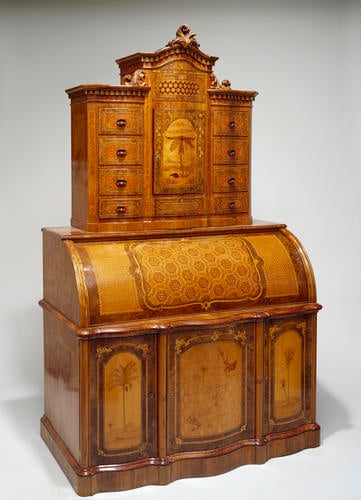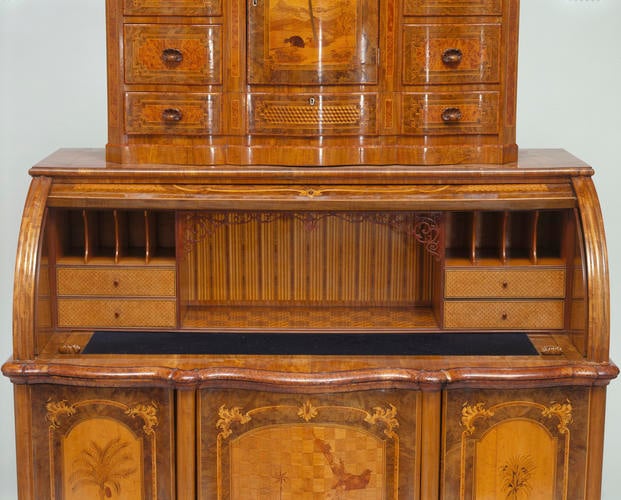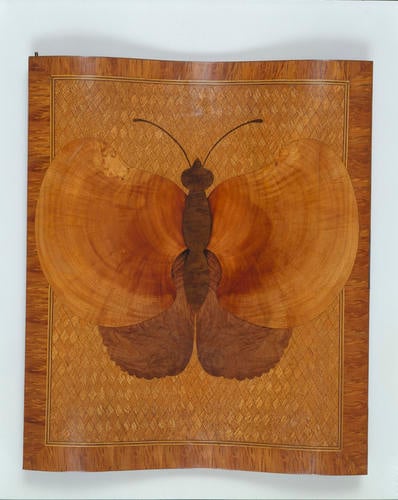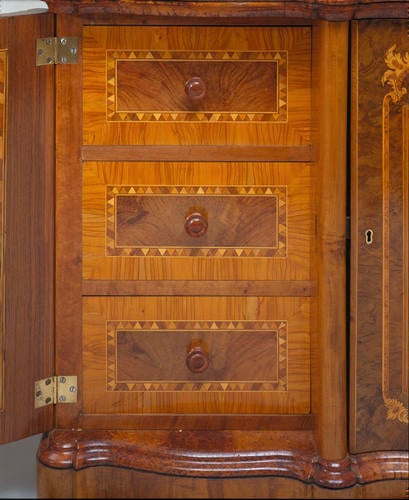Secretaire 1860-62
Burr totara, kauri, rewarewa, maire, cabbage tree, kohekohe | 209 x 124 x 67.5 cm (whole object) | RCIN 100









-
Marquetry roll top desk and superstructure, the central pediment with foliate carving, a central cabinet decorated with a kiwi bird beneath a palm tree in a landscape, a drawer below; four drawers to either side; three cabinets below the tambour top.
This cabinet is one of the most significant pieces of colonial furniture in the Royal Collection. It is the work of the Bohemian émigré Anton Seuffert, who took up residence in Auckland in 1859. He had learnt his skills as a cabinet maker in Vienna in the firm his father worked for, Carl Leistler. Seuffert Snr and Jnr organised the stand for Leistler's Great Exhibition display, their furniture showing the influence of that city's tradition of furniture making in the shape and design of this piece which was sent from New Zealand to form part of the the New Zealand section of the South Kensington International Exhibition of 1862, and was presented to Queen Victoria by the people of New Zealand directly afterwards, purchased for 300 guineas. The presentation of the cabinet to the Queen had been suggested prior to it leaving Auckland and months before the exhibition opened. In 1869, the Queen's son Prince Alfred, Duke of Edinburgh, also patronised Seuffert. Other high quality presentation pieces made by Seuffert in New Zealand included a parquetry fern pattern table presented to the Countess of Aberdeen in 1887 and a card table presented to Major Edward Brooke in 1867 (the latter Woolley and Wallis, 4 October 2023, lot 719).
It is a celebration of the flora and fauna of New Zealand, both in its materials, which include a number of native timbers, and in the subject matter of its exquisitely-formed marquetry panels, one of which is a rendering of a typical New Zealand landscape with a tree fern, kiwi and phormium plants. On a lower panel is a map of the country, and on the inside of the lower door is a large moth, possibly representative of the native puriri moth, which can have a wingspan of fifteen centimetres. Seuffert clearly intended the cabinet to showcase of the suitability of New Zealand timbers for use in cabinet making. However, surprisingly, the cabinet does not feature in any press descriptions of the New Zealand section of the International Exhibition. This must be because it appears to have been severely delayed during its journey from Auckland, arriving some months after the opening of the exhibition. Maybe because of this unfortunate turn of events, Seuffert was unsuccessful in encouraging the widespread use of New Zealand timbers in European cabinet making. However, thanks to the success and fame of this cabinet in his adopted New Zealand, he would become the country's leading cabinet maker during the later nineteenth century, a tradition that his son continued into the mid-twentieth century.Provenance
This secretaire was exhibited in the New Zealand section of the South Kensington International Exhibition of 1862, and afterwards was presented to Queen Victoria by the people of New Zealand.
-
Creator(s)
(cabinet maker)(nationality)Acquirer(s)
-
Medium and techniques
Burr totara, kauri, rewarewa, maire, cabbage tree, kohekohe
Measurements
209 x 124 x 67.5 cm (whole object)
Category
Object type(s)







